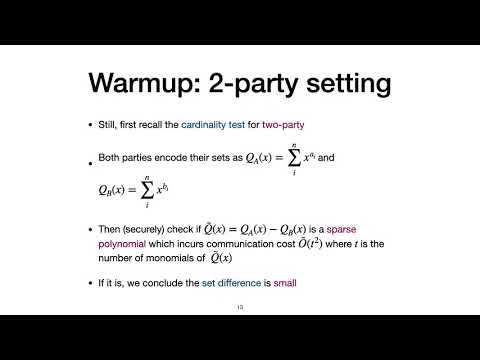CryptoDB
Multiparty Cardinality Testing for Threshold Private Set Intersection
| Authors: | |
|---|---|
| Download: | |
| Abstract: | Threshold Private Set Intersection (PSI) allows multiple parties to compute the intersection of their input sets if and only if the intersection is larger than $n-t$, where $n$ is the size of the sets and $t$ is some threshold. The main appeal of this primitive is that, in contrast to standard PSI, known upper-bounds on the communication complexity only depend on the threshold $t$ and not on the sizes of the input sets. Current Threshold PSI protocols split themselves into two components: A Cardinality Testing phase, where parties decide if the intersection is larger than some threshold; and a PSI phase, where the intersection is computed. The main source of inefficiency of Threshold PSI is the former part. In this work, we present a new Cardinality Testing protocol that allows $N$ parties to check if the intersection of their input sets is larger than $n-t$. The protocol incurs in $\tilde{ \mathcal{O}} (Nt^2)$ communication complexity. We thus obtain a Threshold PSI scheme for $N$ parties with communication complexity $\tilde{ \mathcal{O}}(Nt^2)$. |
Video from PKC 2021
BibTeX
@article{pkc-2021-30998,
title={Multiparty Cardinality Testing for Threshold Private Set Intersection},
booktitle={Public-Key Cryptography - PKC 2021},
publisher={Springer},
doi={10.1007/978-3-030-75248-4_2},
author={Pedro Branco and Nico Döttling and Sihang Pu},
year=2021
}

